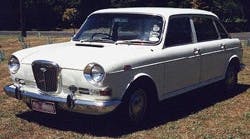In the mid-1970s, I toyed with the idea of taking the car I drove in the U.K. back with me to the U.S. when my overseas assignment ended. I had bought the vehicle when I worked in Paris before I was transferred to London. It was left-hand drive; so it would suit U.S. roads (but it made overtaking (passing) on U.K. motorways challenging at times).
[pullquote] The car was a white 1967 Wolseley 18/85, a conservative British saloon (sedan) that had a polished wood fascia (dashboard) with numerous Smith’s gauges and identical black toggle switches, and plush black leather upholstery. It also sported an illuminated Wolseley badge on the traditional grill (before you dismiss that as British eccentricity, recall, if you’re old enough, that Pontiac offered an optional illuminated “Chieftain” hood ornament in the early 1950s). Besides its looks and comfort, the car’s transverse engine and independent suspension appealed to me.
The Wolseley was made by British Motor Corp. (BMC), which indulged in “badge engineering” — that is, producing nearly identical cars under the Austin, Morris, MG, Riley and Wolseley marques (brands), with Wolseley at the top end. They differed in grill and trim but shared BMC’s reputation for nondescript quality and lackluster reliability.

1967 Wolseley
Not the same British saloon that Mark drove in the 1970s, but close. During home leave in New York, I decided to contact British Leyland, the successor to BMC, at its U.S. headquarters in New Jersey about the availability of parts and service for the car. The people I spoke to hadn’t ever heard of a Wolseley. Obviously, it didn’t make any sense to bring the car to America. Instead I wound up buying a Saab and picking it up in Sweden, but that’s another story.The Wolseley marque is long gone and soon Pontiac will be, too. It’ll be left to car buffs to remember them.Consider what that may mean if an outfit like J. D. Power and Associates 10 years from now conducts a survey about which company made the most reliable or unreliable car you’ve ever owned. People analyzing responses would have to know, should those names be written in, that Wolseley came from BMC and Pontiac from General Motors.Chemical Processing faces the same situation with our Readers’ Choice Awards in which people tell us which firms they consider the technological leaders in more than 40 categories. The survey isn’t multiple choice; instead readers can fill in whatever they wish. This ensures impartiality but adds to our task in tallying responses. We must look out for answers that should be grouped together. The challenge was even greater this year because the survey drew far more responses than ever before.Where a company maintains strong separate brands the task isn’t too difficult. For instance in the Flow Instrumentation category, it’s clear to us to amalgamate Micro Motion citations with those for Emerson Process Management, likewise to credit Emerson for those for Fisher in Valves/Actuators, and Rosemount in Pressure Instrumentation.Dealing with legacy companies can pose a real challenge. For example, we have to remember that ABB encompasses Bailey, Fischer & Porter, Hartmann & Braun, Kent Taylor and other acquisitions as well as Asea and Brown Boveri. Or consider Flowserve — it lists more than 20 heritage brands, including Durco, Gestra, Limitorque, Serck Audco and Worcester Controls, on its Web site. When you think about the number of vendors that have had different names or legacy brands over the years, you can appreciate the scale of the problem.Keeping up with acquisitions is essential. In some categories, for clarity we indicate the purchased company as well as its relatively new parent, e.g., G.E. (Bently Nevada) in Vibration Monitoring Equipment and Siemens (U.S. Filter) in Filtration Systems.Another complication is that some respondents don’t put in a company or brand name at all but instead cite a product. So, it’s up to us to properly credit Autodesk when someone puts in AutoCAD, Honeywell for mentions of Experion, Solutia for Therminol, etc.The Elastomers category presents an additional unique wrinkle. Quite a few respondents cited DuPont Dow. However, that joint venture was dissolved a couple of years ago, with the two companies basically taking back the product lines they had put into the partnership. We’ve taken a pragmatic approach, splitting the DuPont Dow responses equally between the two. We realize this workaround may not exactly reflect the particular products that respondents were focusing on or the relative proportion of the joint venture’s portfolio that the two firm’s contributed. Presumably the issue will diminish as people increasingly realize DuPont Dow is defunct.Suffice it to say that we try our best to ensure results properly represent respondents’ judgments. This takes a lot of work but it’s necessary if we’re to provide as much value as possible to you. In line with that, please let us know what enhancements you’d like to see in next year’s Readers’ Choice survey.Mark Rosenzweig is Chemical Processing's Editor-in-Chief. You can e-mail him at[email protected].Latest from Home
Latest from Home
Sponsored Content
